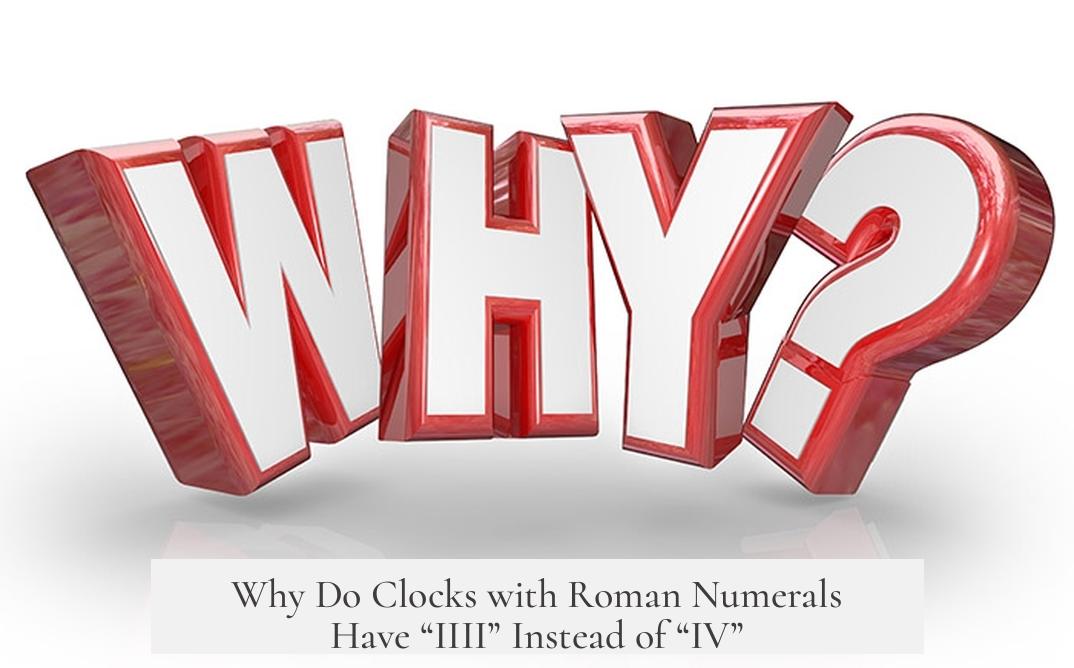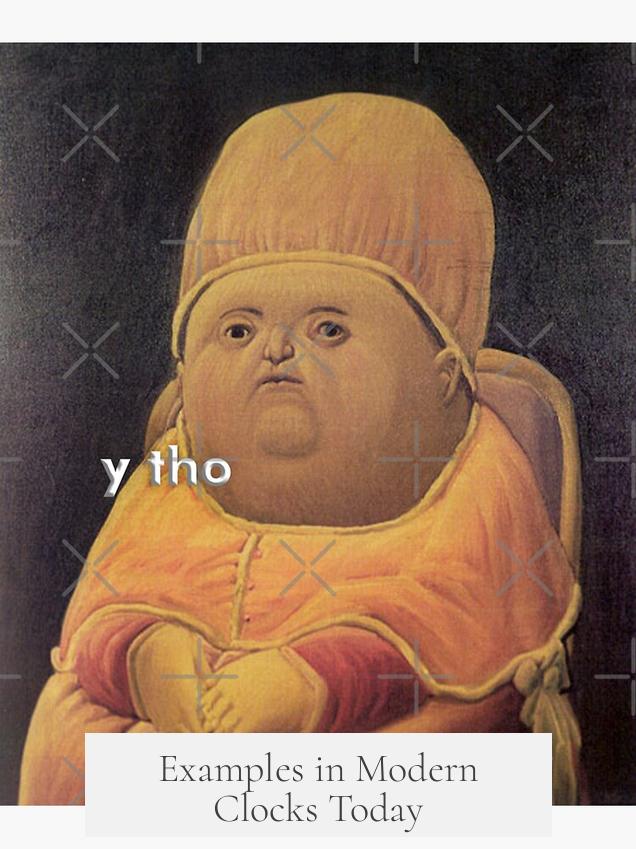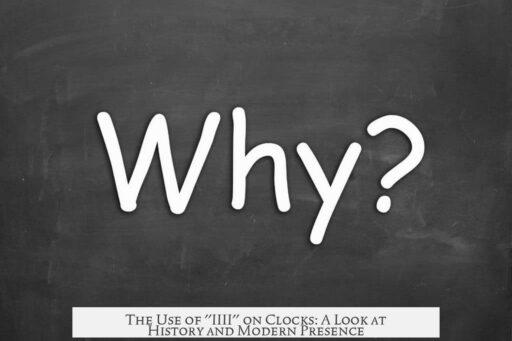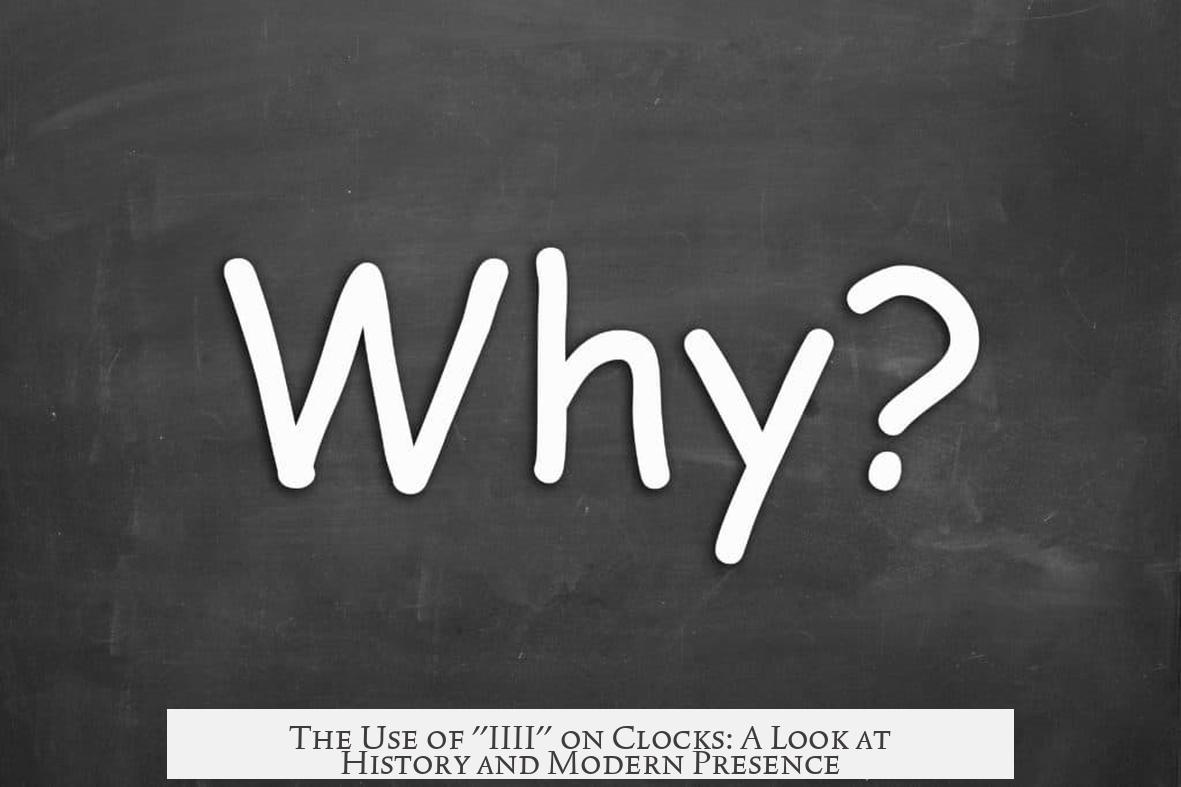Clocks with Roman numerals often display “IIII” instead of “IV” due to historical and practical reasons rooted in medieval traditions. This convention dates back to the Middle Ages when mechanical clocks first emerged.
During the Middle Ages, the use of Roman numerals followed different practices compared to modern conventions. The subtractive notation “IV” was not widely used then. Instead, people favored the additive form “IIII” to represent the number four. For example, medieval texts frequently showed numbers like “viiii” or “viiij” rather than “ix,” reflecting additive numeral usage.
A notable example is the Durham Cathedral clock from around 1500, which uses “IIII” on its face. This confirms the widespread medieval preference for additive numerals. Conversely, the Prague Orloj Astronomical Clock, built circa 1410, employs “IV,” showing that some variation existed even in early clockmaking.
The predominance of “IIII” on many historic mechanical clocks relates to this medieval tradition. The clockmakers likely followed the common numeral style of their time. Additionally, “IIII” offers visual balance on clock faces, aligning better with the symmetrical distribution of other numerals.
- “IIII” is a more straightforward additive form, matching the style used in medieval documents.
- “IV” is subtractive, less common during the period when first clocks were made.
- Some clocks from the Middle Ages demonstrate both forms, indicating local preferences.
Over time, the tradition of using “IIII” persisted on many clock faces for aesthetic and historical reasons, even as subtractive notation became the norm in general Roman numeral usage.
| Clock | Approximate Date | Roman Numeral for Four |
|---|---|---|
| Durham Cathedral Clock | circa 1500 | IIII |
| Prague Orloj Astronomical Clock | circa 1410 | IV |
- Medieval clockmakers adopted additive Roman numerals, influencing the use of “IIII”.
- “IV” was less common in medieval numeral writing styles.
- “IIII” provides balanced and traditional numeral arrangement on clock faces.
Why Do Clocks with Roman Numerals Have “IIII” Instead of “IV”?

Simply put, clocks use “IIII” rather than “IV” because the use of additive Roman numerals like “IIII” was more common historically, especially in the Middle Ages when mechanical clocks first emerged. This tradition remains alive on many clock faces today, blending history, practicality, and a dash of ancient numeral quirks.
Now, let’s explore why that is, without confusing you with an ancient math lecture.
The Medieval Roots of “IIII” on Clock Faces
Mechanical clocks first appeared in medieval Europe, around the 14th and 15th centuries. Back then, the way people wrote the number four wasn’t standardized. The two main forms were the additive “IIII” (literally I+I+I+I) and the subtractive “IV” (5 minus 1).
The famous Durham Cathedral clock from around 1500 shows the four as “IIII,” while the Prague Orloj astronomical clock dating back to about 1410 displays the four as “IV.” This shows that even among early clockmakers, there was no strict rule—both worked just fine.
Medieval scribes and craftsmen favored additive forms more often. They’d rather write “IIII” or “viiii” than “IV” or “IX.”
Why Additive Notation Was the Norm Back Then
You might ask, “Was ‘IV’ considered wrong?” No – it just wasn’t as common. The subtractive style came later and was less popular among everyday users of Roman numerals.
In medieval texts and documents, additive forms like “IIII” and “viiii” dominated. The subtractive “IV” showed up less frequently. It’s like how some people still say “fourteen” while others stick with “four and ten” in older dialects, but that’s for another day.
One theory is that additive numerals were easier to carve into stone or metal, which was useful when clock faces were handmade.
Practical Reasons for Using “IIII” on Clock Faces
Beyond history, there’s practicality. Using “IIII” helps clockmakers balance the dial visually.
- “IIII” has four characters; “VIII” (8) has four characters as well. Placing “IIII” opposite “VIII” helps the clock face look balanced.
- Symmetry matters on clock faces—they want the whole thing pleasing to the eye, not top-heavy or lopsided.
Imagine staring at a clock where the left side looks cramped and the right side stretched out. Not pretty, right? So, “IIII” above the “VIII” keeps things even.
Examples in Modern Clocks Today

If you ever peek at traditional clocks—grandfather clocks, old wall clocks—they often keep “IIII.” Even many luxury watchmakers use “IIII,” partly out of respect for tradition and partly because the look works.
Interestingly, some modern clocks use a mix. They might have “IIII” for four but “IX” (subtractive) for nine. This inconsistency hints that tradition and aesthetics trump strict numeral rules.
But Could “IV” Be Avoided for Other Reasons?
Some suggest that using “IV” could cause confusion. The letters “I” and “V” represented the Roman god Jupiter (Latin: IVPPITER). Avoiding “IV” might have been a way to steer clear of any religious or superstitious implications.
However, this idea is more folklore than rigorously documented history. Yet, it’s a fun tidbit to make your next trivia night sparkle.
So What Does This Mean for Clock Lovers Today?
The choice between “IIII” and “IV” isn’t a question of being right or wrong—it’s about tradition, history, and style.
From a practical standpoint, “IIII”:
- Reflects historical medieval numeral forms
- Enhances symmetry with “VIII” on the dial
- Respects centuries-old clockmaking craftsmanship
For the curious collector or watcher enthusiast, knowing the story behind “IIII” adds an extra layer of charm when gazing at the face of a classic clock.
Can You Spot Which Clocks Use “IIII” or “IV”?
Challenge yourself next time you visit a museum or antique shop. Look at the clock face and guess if it uses “IIII” or “IV” before checking closely. It’s like hunting for historical clues hidden in plain sight.
Remember, both “[IV](https://en.wikipedia.org/wiki/Roman_numerals#IV:_four)” and “[IIII](https://en.wikipedia.org/wiki/Clock#Roman_numerals)” are valid Roman numerals, but the choice made centuries ago shapes today’s clock aesthetics.
Final Thoughts: Why This Quirk Matters
Roman numerals on clock faces aren’t just old-fashioned decoration. They connect us with medieval history, mechanical ingenuity, and medieval attitudes toward numbers and notation.
Using “IIII” instead of “IV” is a nod to the past, a practical design choice, and sometimes a piece of superstition. It reminds us that even something as everyday as reading the time can hold layers of history and meaning.
Next time you glance at a clock face, appreciate the story behind those four marks. Clockmakers centuries ago left us a charming puzzle in plain sight—will you keep the tradition alive?



